PERFECTLY BAKED SAUNA EGGS
SOMEWHERE IN BETWEEN 50~55 MINUTES, IS THE FIFTY SHADES OF YELLOW
OK, I admit. For someone who has, more than once, cried sympathy for her egg-allergy, I spend an unnatural amount of time studying the perfect way to cook them. Not just on my shortcut – 15 seconds to be exact – to creamy and velvety scrambled eggs, but there are up to this point… THREE POSTS in total, solely dedicated to detailed ways of making onsen tamago, aka hot spring eggs. There was the genesis-post (where my heartbreaking journey on losing one of my favourite things to eat was well documented), then a second one, then a third one. And now, here’s the fourth.
But, this post isn’t technically about “onsen/hot spring” eggs, where the eggs are submerge in a hot bath of a constant temperature at 158F/70C. If I may, this is more about something I’d like to call, the sauna eggs. And this could proven a revelation for those of you out there, who aren’t particular keen on babysitting a thermometer and a pot of hot water, because these, these are baked in the oven.
This mad scientific conduct came after I spotted this on Pinterest a few days ago. But instead of omg-this-is-genenius-!, I said to myself, holy-shit-what-a-waste-!. I mean, if someone were to look for a no-fuss method of cooking something, it shouldn’t be applied to what’s already the most fuss-less thing to do on earth, like hard-boiling an egg… Instead, it should be calibrated, fine-tuned, solely dedicated to achieving the most elegantly beautiful transformation of a single ingredient, this mother earth has to offer.
So I set out my expedition on Wednesday. Three cartons of eggs and a few disappointments later, I’ve arrived at the truth. Now, there are obviously 2 major factors at play here, being the temperature, and the cooking time. The temperature, in this case a less interesting subject, is found to be sitting slightly higher than the hot bath-method, at 175F/80C ~ 185F/85C. But the cooking time is what’s really interesting here. Somewhere in between 50~55 minutes, is where the fifty shades of yellow happen.
Judging purely from the appearance of the cracked eggs, you may think there isn’t much difference between 45 to 55 minutes. And that’s because the difference lies within the yolk. At 45 minutes, the yolk is still very runny and almost completely raw. Then at 50 minutes, the yolk has thickened slightly, runs slower, but still hasn’t hit the sweet spot of resembling thick custard. But in the next mere 5 extra minutes, you can see how the yolk has completely solidified, overcooked, looking more like a soft-boiled egg than what we really want.
The conclusion? A very specific 53 min at a temperature between 175F/80C ~ 185F/85C. Little, precious, opaque jewels of deliciousness with a texture lurking between the lines of fluid and solid, jelly and custard. They are perfect, worth every pain of a one-way infatuation from afar, well, for me at least. For you, it’s gonna be a full-blown romance.
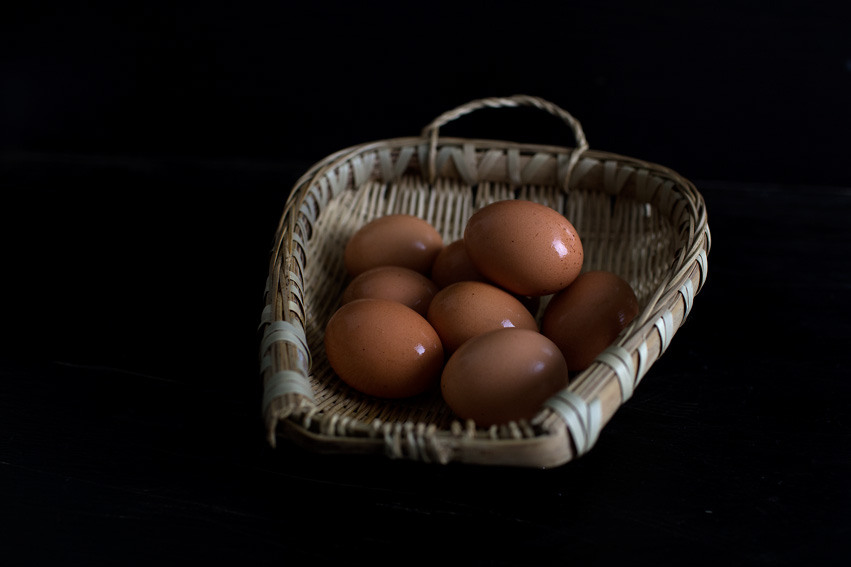
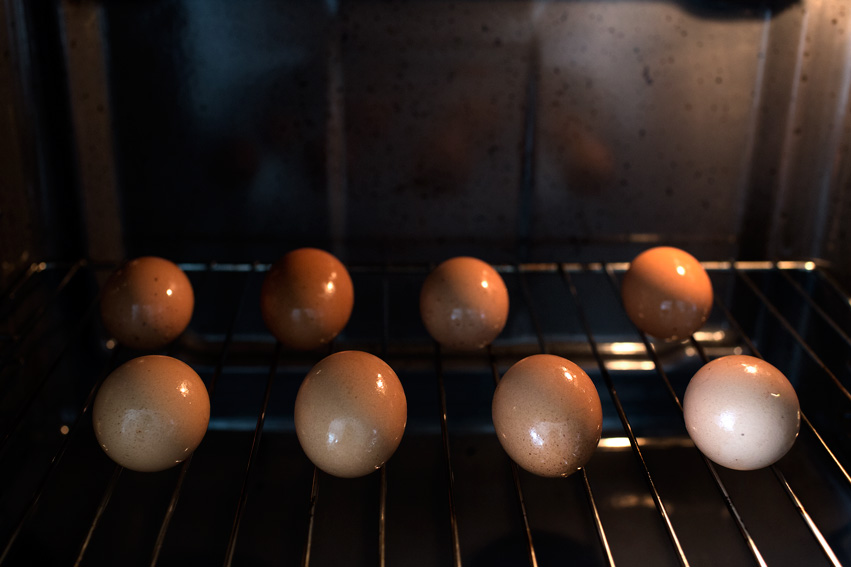
Ingredients
- 4~8 large eggs, cold from the fridge is fine
Instructions
- HIGHLY HIGHLY recommend using an oven-thermometer. I've tried with both room-temperature eggs and cold eggs from the fridge. The cooking time didn't vary that much.
- If you don't have an oven thermometer, that's ok (but it can be tricky). We know that every oven is different, but here's what I've found out monitoring mine. When right after the oven tells you that it's preheated, the actual interior temperature is usually much lower than the setting. Which is why we are going to preheat it at a higher temperature first, so it hits our goal-temperature from the get-go.
- Our desired temperature is around 175F/80C ~ 185F/85C throughout the cooking process. So preheat your oven on 210F/100C, then once it's done preheating, place the eggs on a baking-rack with at least 2" (5 cm) of space in between each (try to do this quickly so the oven doesn't lose heat). Close the oven, then *lower the temperature down to 185C/85C. The interior temperature will fluctuate, but the range is usually slightly lower than the setting instead of higher (again, every oven is different). For my oven, by setting it on 185F/85C, the temperature will fluctuate between that and 175F/80C, which is exactly what we want.
- Now, DO NOT OPEN THE OVEN during the cooking process. You will lose precious heat especially at such low temperature. Set your timer for 53~54 min. Because every oven is different, you can try cracking one open at 53 min, and judge from there whether you want more doneness or not.
- When the timer goes off, immediately remove the eggs and submerge in cold water, for at least 10 min, to stop the cooking. You can keep the eggs at room-temperature for 1 day, in the fridge for several days. To bring it back to room-temperature, submerge the in warm water for 10 min.


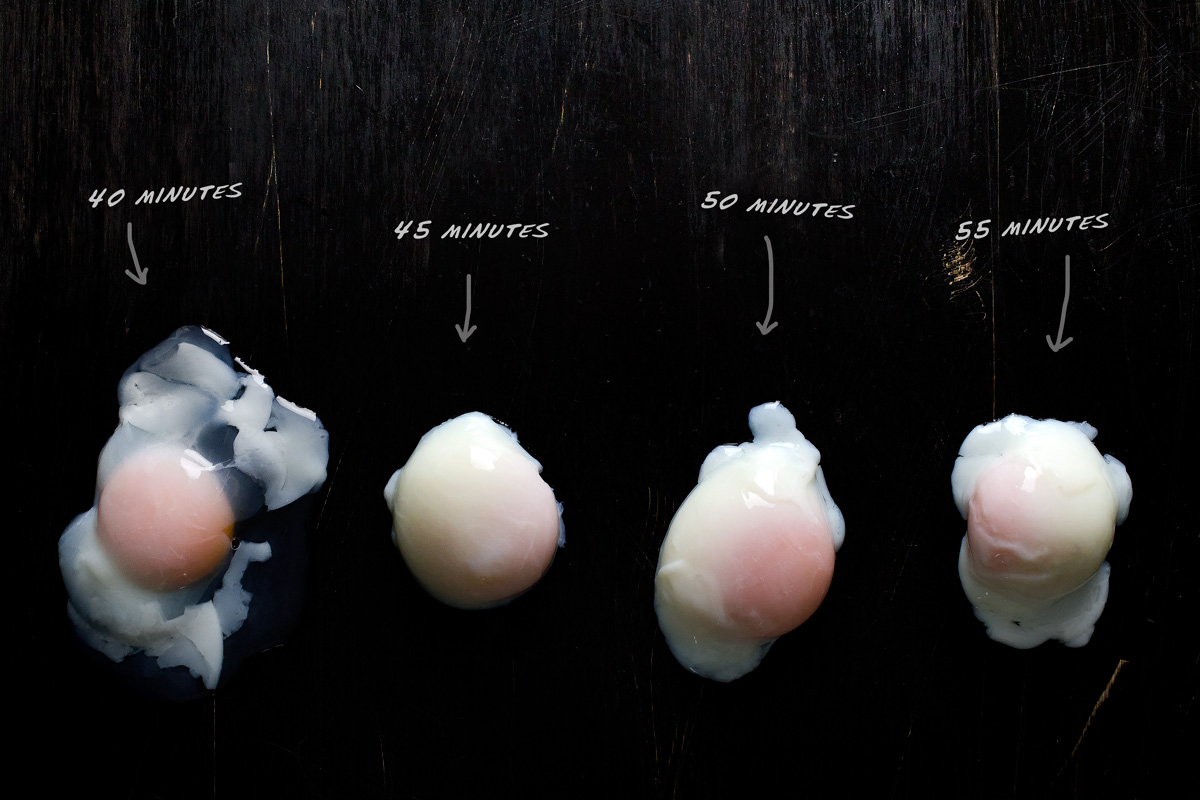
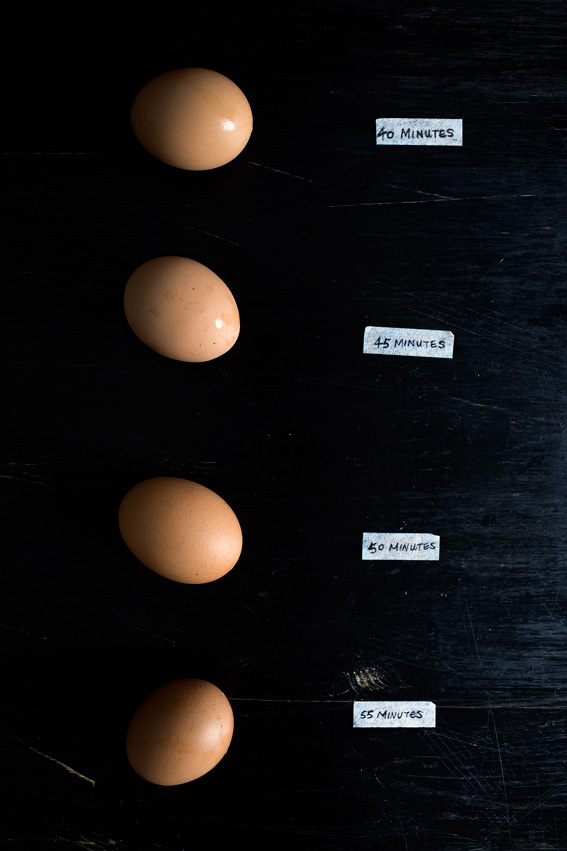
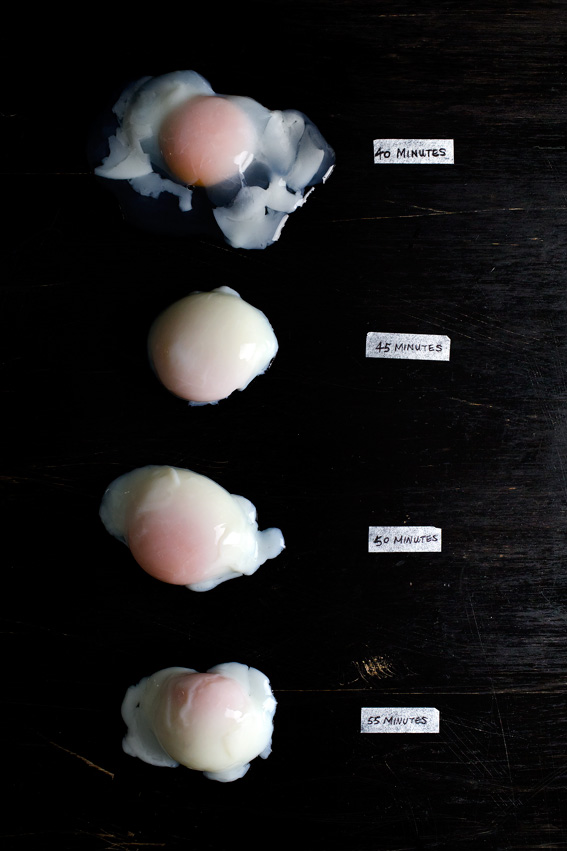

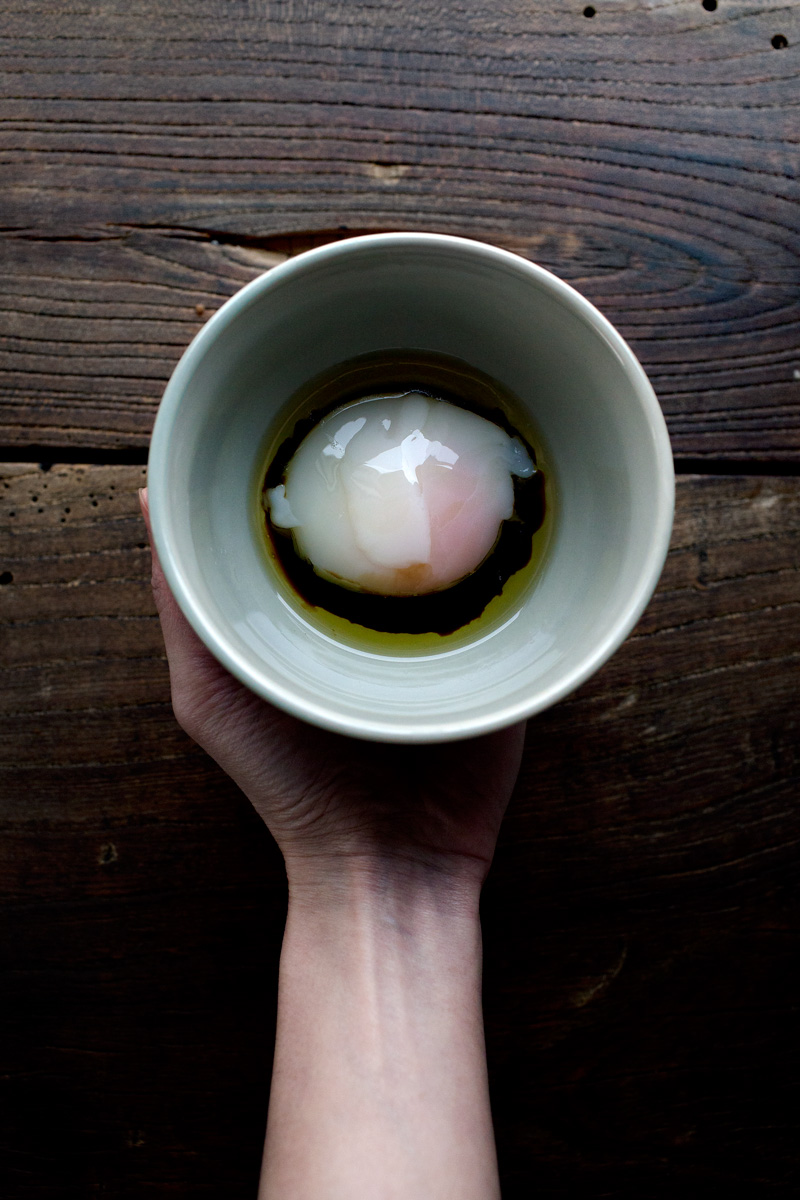
Betty
03.06.2015at9:22 PMMandy you are a genius.
Charlie (Chockywoky)
03.06.2015at9:55 PMAll hail Mandy,absolute genius cum egg specialist,
Thank you so, incredibly much for sharing this genius piece of information. The world has been saved.
Dulcistella
03.06.2015at9:56 PMBtw, I never said thank you for the 15-seconds scrambled eggs… now they’re my favorite!
Katrina @ Warm Vanilla Sugar
03.06.2015at10:04 PMThose eggs look dang perfect girl! I’m all over these!
Carla
03.06.2015at10:54 PMWhich is the best way to eat them?
mandy@ladyandpups
03.06.2015at11:48 PMCarla, tons! You can add sesame oil and konbu soy sauce like in the photos, or put one on top of a simple pasta, or on grits/polenta, or in noodle soups…. On and on and on…
Ursula @ LilVienna.com
03.06.2015at11:37 PMThe eggs look really cool. Thanks. I think I’ll try the 55 minutes version ;-)
Rebecca @ DisplacedHousewife
03.07.2015at1:26 AMYour photos are always gorgeous. This would be amazing on top of some pesto pasta.
Christine
03.07.2015at5:06 AMHow impossible are these to peel? They look absolutely gorgeous!
mandy@ladyandpups
03.07.2015at1:48 PMChristine, you don’t peel them! The egg will slide off once the shell is cracked! Magic….
Matthew
03.08.2015at3:29 AMThank you excellent recipe. Also please update us if you win the blog nomination.
Lila
03.08.2015at4:20 AMVery informative and I love that you took the guess work out and made it very easy to SEE how long I should bake them.
ellie | fit for the soul
03.09.2015at10:12 PMOoooohhhhh this is so cool! I’ve wanted to bake the whole actual egg before but was scared it would burst or somethin’. Will have to try this–sounds so fun and unique! :D
Uncle Tommy
03.11.2015at6:03 AMThanks for the very scientific methods and explanations. Very keen to try this.
Can u tell me your oven size?
Thanks
mandy@ladyandpups
03.11.2015at12:47 PMUncle Tommy, my oven is about 16″, 40 cm wide on the INSIDE. A typical wall-unit built-in oven.
Pamela
03.12.2015at10:13 AMHow did I miss this when it came out??!! This is madness! This is genius! This is wonderful!
Of course, I can go to any supermarket in Japan and BUY these already made.
d(^_^o)
But knowing how to make them myself and so easily…. is magic!!
Thank you, oh so kind Mandy, maker of easy egg dishes!
Maybe the egg goddess will relent and grant you freedom from your egg allergy!
Let us pray!
Peter
03.12.2015at4:29 PMHow does one go about peeling these? It didn’t slide out easily at all, the whites kinda plopped out and the yolk went nowhere :(
mandy@ladyandpups
03.12.2015at5:00 PMPeter, I’m not sure I understand. The yolk went nowhere? Could you describe a bit more? If the egg white is sticking to the shell too much, it means the temperature is too high, and the eggs whites are overcooked. Every oven is different, and without an oven thermometer, your oven may be cooking at a higher temperature than the setting. Try lowering it 5C. It’s impossible to project the exact same cooking-time or temperature for every ovens, so you may have to play with it a couple times.
Peter
03.12.2015at5:27 PMI think I was confused, because the whites SEEMED under and the yolks over, but maybe they were both just over :)
Either way the whites kinda came out and the yolk had to be scooped out.
Suffice to say if its cooked as planned it’ll come out of the shell pretty easily?
mandy@ladyandpups
03.12.2015at5:37 PMYes, it should just slide out. For the record, I used cold eggs from the fridge. It does sound like the eggs are overcooked. I would suggest removing the eggs 3 minutes earlier, and see if that works. If not, try with 1 egg each time (so you don’t waste more eggs), with the oven temperature 375F/190C the first time, then 355F/180C the second time, and see what it does. Sorry, it does require a bit of getting-to-know-your-oven.
Allyn
03.13.2015at9:35 PMThis is nothing short of brilliance.
Leslie
04.13.2015at9:18 PMhow are they getting out of the shell? do you peel them or crack them? do they fall out easily? i’ve always wondered how people get a soft-boiled egg out of the shell. it never works for me.
Leslie
04.13.2015at9:25 PMDOH! forget my question. i didn’t read all of the comments.
Serena
06.06.2015at12:22 PMHi Mandy~ My eggs cracked open after 20min in the oven, on a few the yolk has dripped out…any suggestions?
mandy@ladyandpups
06.06.2015at2:06 PMSerena, oh no! That has never happened to me! I’m guessing the temperature is too high? Preheat on and cook with 185f/85c and see. Do you have an oven thermometer? Because every ovens eats differently, and so it does take a bit of trial and error. Or try with room temperature eggs. I always put cold eggs straight from the fridge and they never cracked though…
babykitted
03.22.2016at3:30 PMWow!!!!!!!!!!!! When is a good occasion to serve this? Is this more of a snack and not a side dish? I’d really like to make this, but when is it most appropriate?
Prudence Marule
05.10.2016at5:35 PMoh my god!! how did i miss this?? perfect BAKED eggs!!